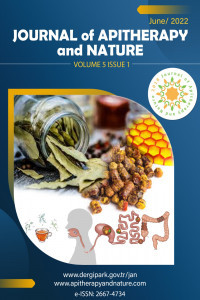Isolated Xanthones from Lisotrigona furva Propolis in Vietnam
Isolated Xanthones from Lisotrigona furva Propolis in Vietnam
Propolis, Lisotrigona furva, Xanthones,
___
- 1. Sanpa S., Popova M., Bankova V., Tunkasiri T., Eitssayeam S., Chantawannakul P. (2015). Antibacterial compounds from propolis of Tetragonula laeviceps and Tetrigona melanoleuca (Hymenoptera: Apidae) from Thailand. PLoS One, 10(5), e0126886.
- 2. Boonnak N., Karalai C., Chantrapromma S., Ponglimanont C., Fun H. K., Kanjana-Opas A., Chantrapromma K., Kato S. (2009). Anti-Pseudomonas aeruginosa xanthones from the resin and green fruits of Cratoxylum cochinchinense. Tetrahedron, 65(15), 3003-3013.
- 3. Li Z., Song Y. H., Uddin Z., Wang Y., Park K. H. (2018). Inhibition of protein tyrosine phosphatase 1B (PTP1B) and α-glucosidase by xanthones from Cratoxylum cochinchinense, and their kinetic characterization. Bioorganic & medicinal chemistry, 26, 737-746
- Yayın Aralığı: Yılda 2 Sayı
- Başlangıç: 2018
- Yayıncı: Oktay YILDIZ
Chemical Profiling of Papua New Guinea Propolis and Assay its Antiprotozoal Activity
Samya ALENEZI, Naif Alenezi MANAL, J NATTO, Harry P. De KONING, John IGOLI, David G. WATSON
Zaccaria VINCENZO, Galeotti FABIO, Fachini ALFREDO, Passarella PAOLO, Daglia MARIA, Volpi NICOLA
The Efficacy of Propolis Fluoride in Inhibiting Dental Caries Activity on Primary Teeth
Risqa Rina DARWITA, Iwany AMALLIAH, Sri Angky SOEKANTO, Muhamad SAHLAN
Soumaya TOUZANI, Sleman KADAN, Abdalsalam KMAIL, Bashar SAAD, Badiaa LYOUSSI
Hristo PETKOV, Boryana TRUSHEVA, Milena POPOVA, Vassya BANKOVA
Can Propolis Inhibit Infection Dynamics of Honey Bee (Apis mellifera L.) Viruses in vitro?
New Insights into Tropical Propolis: Propolis from Pitcairn Island
Boryana TRUSHEVA, Kristina GEORGIEVA, Milena POPOVA, Veselina UZUNOVA, Tihomira STOYANOVA, Violeta VALCHEVA, Rumiana TZONEVA, Vassya BANKOVA
Y. FRIÓN-HERRERA, D. GABBIA, M. CARRARA
Phenolic Compounds of Spain Propolis
Félix ADANERO-JORGE, M Camino GARCÍA-FERNÁNDEZ, Rosa M VALENCIA-BARRERA, J. Javier SANZ-GÓMEZ
